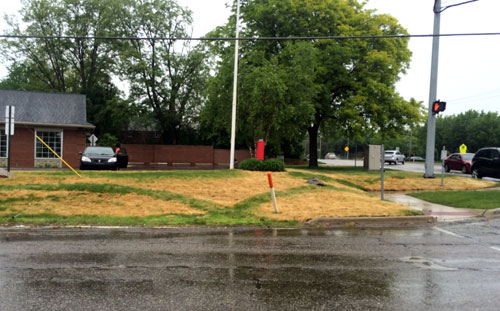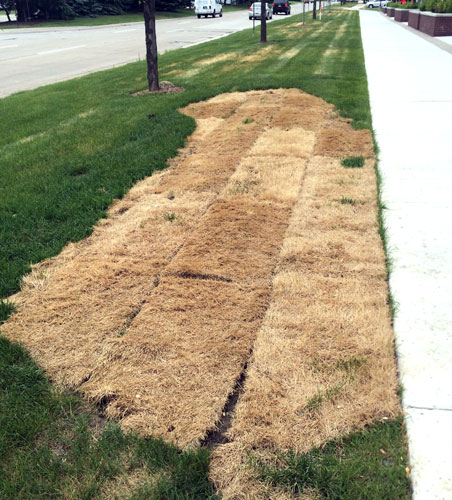Memorial Day heat and wilt stress on lawns
The warm, dry conditions over the Memorial Day weekend caught some turf unprepared.
It may seem hard to believe with the cool spring we’ve been living through, but in the last week I’ve been noticing sporadic wilt damage on lawns, boulevards and commercial properties. It seems that following the rather cool, damp spring, the short stretch of warm, dry weather we had in and around the Memorial Day weekend, May 24-26, 2014, caused some turf wilt and heat tracking damage. Damage was particularly evident in areas that were either in close proximity to roads, in turf with a short root system such as new sod, or a combination of these factors when irrigation was left off during this warm period.

Turf stressed from spell of warm, dry weather. Notice the green arcs from a poorly pressurized irrigation system. Photo credit: Kevin Frank, MSU
For the lack of a better term, I call the damage imposed from any sort of trafficking on heat or wilting turf “heat tracking.” Often, heat tracking is the result of mowers running over the turf when it is near the wilting point. Some will misdiagnose tracking damage as being from a pesticide or fertilizer application. The resultant damage may look like Roundup was on the tires of the equipment, but it’s simply from traffic on turf during wilting. Michigan State University Extension says really the only way to avoid this damage is to avoid mowing during the hottest time of the day when the turf is under stress.

New sod that wasn’t watered and heat tracking from mowing in the background. Photo credit: Kevin Frank, MSU
Although heat tracking and wilt damage can look really bad, the good news is the recent rains and cool temperatures should help the turf recover within a week or two. However, for any new sod that was allowed to dry, it’s most likely going to need to be replaced.
Dr. Frank's work is funded in part by MSU's AgBioResearch.



 Print
Print Email
Email


